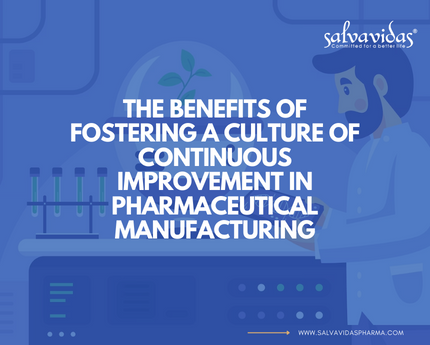
The Benefits of Fostering a Culture of Continuous Improvement in Pharmaceutical Manufacturing
Introduction:
In the fast-paced and competitive world of pharmaceutical manufacturing, success is often measured by the ability to produce high-quality products consistently and efficiently. Companies that prioritize innovation and continuous improvement are more likely to thrive in this industry, gaining a competitive edge and meeting the ever-evolving needs of consumers. In this article, we’ll explore the benefits of fostering a culture of continuous improvement in pharmaceutical manufacturing and how it can help companies achieve their goals.
Understanding Continuous Improvement:
Continuous improvement refers to an ongoing effort to identify areas for improvement and implement changes that lead to positive results. This approach involves analyzing current processes, identifying areas for improvement, testing new ideas, and implementing changes that result in improved efficiency, productivity, and quality. In pharmaceutical manufacturing, this can involve adopting new technologies, implementing best practices, and fostering a culture of innovation and experimentation.
The Advantages of Fostering a Culture of Continuous Improvement in Pharmaceutical Manufacturing:
Improved Product Quality: Continuous improvement programs focus on identifying and addressing potential quality issues, resulting in better products that meet or exceed customer expectations.
Increased Efficiency: By continually evaluating processes and seeking out ways to improve them, companies can streamline their operations, reduce waste, and improve productivity.
Reduced Costs: By eliminating waste and streamlining processes, companies can reduce their operating costs, which can translate into increased profitability.
Better Regulatory Compliance: A culture of continuous improvement encourages companies to stay up-to-date with regulatory requirements, ensuring that products meet all necessary guidelines.
Improved Employee Engagement: Fostering a culture of innovation and experimentation can increase employee satisfaction and engagement, leading to better productivity and retention rates.
The Key Components of a Culture of Continuous Improvement:
Leadership Commitment: A culture of continuous improvement must be embraced at all levels of the organization, with leaders setting the tone for innovation and experimentation.
Open Communication: An environment of open communication and collaboration is essential for sharing ideas and identifying areas for improvement.
Data-Driven Decision-Making: A data-driven approach to decision-making ensures that changes are evidence-based and rooted in measurable outcomes.
Employee Empowerment: Empowering employees to identify and implement changes fosters a sense of ownership and engagement in the process.
Implementing a Continuous Improvement Program: Tips for Success
Set clear goals and objectives that align with the company’s overall mission and vision.
Establish a system for tracking progress and measuring results.
Communicate the benefits of the program to employees, highlighting how it can benefit both the company and individual employees.
Provide adequate training and resources to employees to support the implementation of the program.
Encourage experimentation and risk-taking, creating an environment where failure is viewed as an opportunity to learn and improve.
FAQs:
Q: How can continuous improvement help companies stay competitive in the pharmaceutical manufacturing industry?
A: By continually seeking out ways to improve processes and products, companies can stay ahead of the competition and meet the ever-evolving needs of consumers.
Q: How can a culture of continuous improvement benefit employees?
A: A culture of innovation and experimentation can increase employee engagement and job satisfaction, leading to better retention rates and overall productivity.
Q: What role do leaders play in fostering a culture of continuous improvement?
A: Leaders play a critical role in fostering a culture of continuous improvement, setting the tone for innovation and experimentation, and providing the necessary resources and support to employees.
Q: Is it possible to implement a culture of continuous improvement in a small pharmaceutical manufacturing company?
A: Yes, it is possible to implement a culture of continuous improvement in any size company. In fact, small companies may find it easier to implement a program since they have fewer resources and employees to manage.
Conclusion:
In today’s competitive pharmaceutical manufacturing industry, continuous improvement is essential for companies looking to stay ahead of the competition and meet the evolving needs of consumers. By fostering a culture of innovation and experimentation, companies can improve product quality, increase efficiency, reduce costs, and improve employee engagement. Implementing a continuous improvement program requires commitment and support from all levels of the organization, but the benefits are well worth the effort. By prioritizing continuous improvement, companies can ensure long-term growth and success in this dynamic industry.




0